Hydroponic Guide for Feminized Cannabis Seeds
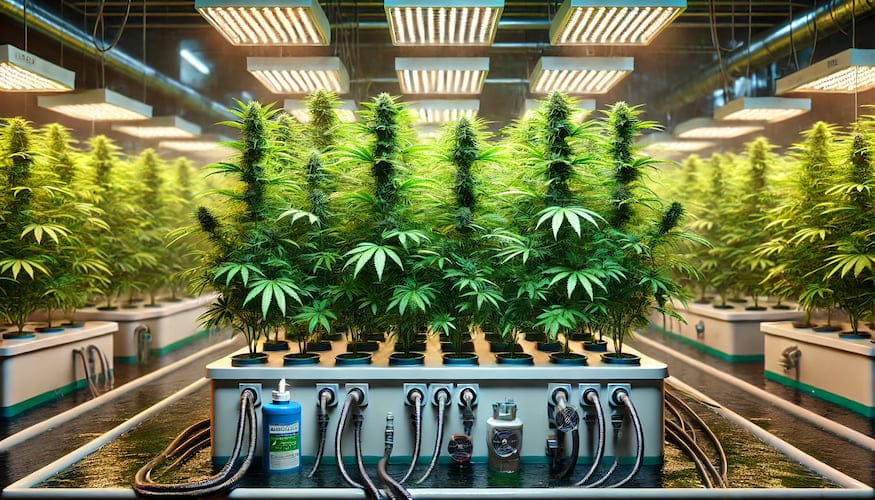
Are you ready to take your cannabis cultivation to the next level? Imagine faster growth, larger yields, and optimal plant health. It’s time to explore the world of hydroponics for growing feminized seeds. Discover the secrets to achieving exceptional results with this innovative soilless method.
Hydroponics, using water as the primary medium, offers numerous advantages over traditional soil cultivation. Not only does it promote faster plant growth, but it also allows for precise control of nutrients, pH levels, and lighting conditions. With the right setup and knowledge, you can create the perfect environment for your feminized seedlings to thrive.
Whether you’re a seasoned cultivator or a beginner, our comprehensive guide will walk you through the essential steps and techniques needed to succeed in hydroponic cannabis cultivation. From selecting the ideal growing medium and setting up your indoor hydroponic system to optimizing nutrient intake and harvesting your high-quality feminized buds, we’ve got you covered.
Join us as we delve into the world of hydroponics and uncover the tips, tricks, and best practices for growing feminized seeds in these innovative systems. It’s time to unlock your cannabis cultivation potential and embark on an exciting journey towards higher yields and exceptional quality.
Are you ready to dive into the world of hydroponic cultivation? Let’s get started!
Key Takeaways:
- Hydroponics offers faster plant growth and larger yields compared to soil cultivation.
- Select the right growing medium and setup for your hydroponic system.
- Optimize nutrient intake, pH levels, and lighting conditions for optimal plant growth.
- Learn the best techniques for harvesting your feminized buds.
- Unleash your cannabis cultivation potential with hydroponics.
The History of Hydroponics
Hydroponic cultivation has a rich history that dates back thousands of years. Its origins can be traced back to ancient civilizations such as Babylon and the Aztecs, who practiced the art of growing plants in water without soil. These ancient cultures discovered innovative ways to cultivate crops in different environments, showcasing their resourcefulness and ingenuity.
Over time, hydroponics has evolved and advanced with the contributions of scientists and researchers. These advancements have led to the development of various methods and systems that optimize plant growth and maximize yield. Hydroponics has become a modern, efficient, and sustainable way to grow plants.
Over the centuries, hydroponics has continued to gain popularity and scientific recognition. From the groundbreaking research of Sir Francis Bacon in the 17th century to the discoveries of modern scientists, the field has witnessed significant advancements.
Ancient Civilizations and Early Hydroponic Cultivation
Ancient civilizations such as the Babylonians and the Aztecs are known for their early use of hydroponics. The Hanging Gardens of Babylon, one of the Seven Wonders of the Ancient World, is believed to have incorporated hydroponic principles. This marvel of engineering showcased the ability to grow plants using water and a system of channels to distribute nutrients.
The Aztecs, with their sophisticated knowledge of agriculture, built floating gardens known as chinampas. These man-made islands were used to grow crops in the shallow waters of lakes, leveraging the natural nutrients present in the water. This ancient hydroponic system and its efficiency in maximizing crop yield are still admired today.
Hydroponic Advancements: From the 17th Century to Today
Hydroponics gained significant recognition in the 17th century when Sir Francis Bacon conducted experiments on plant growth using water as a medium. His work laid the foundation for future advancements in hydroponic cultivation.
In the early 20th century, researchers such as Julius von Sachs and William Frederick Gericke further expanded the understanding of hydroponics. Gericke’s pioneering work led to the development of the first large-scale hydroponic systems, revolutionizing modern agriculture.
Since then, hydroponic technology has continued to evolve and improve. Innovations such as drip irrigation, nutrient film technique (NFT), aeroponics, and deep water culture (DWC) systems have made hydroponic cultivation more accessible and efficient. These advancements have allowed for precise control over factors such as nutrient delivery, temperature, and lighting, maximizing plant growth and yield.
The Future of Hydroponics
The journey of hydroponics from ancient civilizations to modern advancements demonstrates its potential as a sustainable and efficient method of cultivation. As technology continues to advance, hydroponics is poised to play a significant role in addressing food security and sustainability challenges.
The future of hydroponics holds promise for optimizing resource utilization, reducing water consumption, and expanding the possibilities of urban and vertical farming. With ongoing research and innovation, hydroponics has the potential to transform agriculture and shape a more sustainable future.
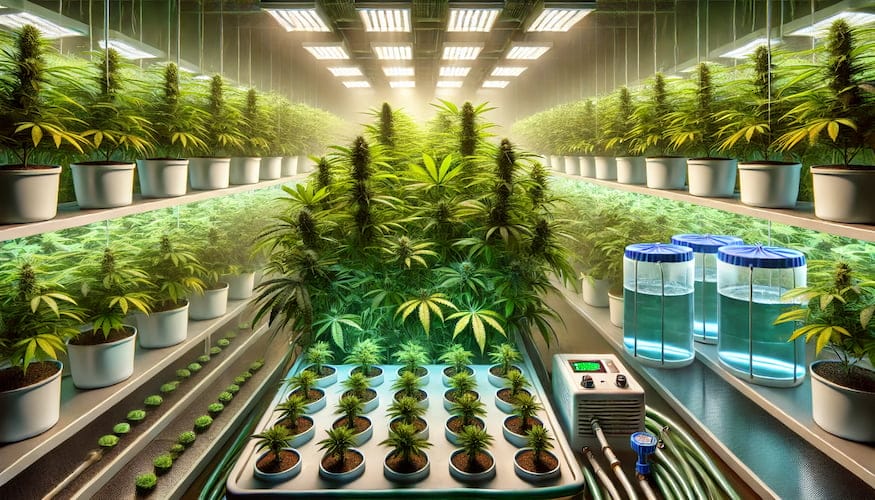
The Advantages of Hydroponic Growing
Hydroponic growing offers numerous advantages that make it a popular choice for cultivating plants. From faster plant growth to larger yields, hydroponics provides a range of benefits that have revolutionized modern agriculture.
Faster Plant Growth
One of the most significant advantages of hydroponic growing is the remarkable speed at which plants develop. Hydroponic plants typically experience 30 to 50 percent faster growth compared to their soil-grown counterparts. This accelerated growth rate can be attributed to the optimized growing conditions provided by hydroponic systems, which ensure the plants receive all the necessary nutrients and have access to ample oxygen.
Larger Yields
In addition to faster growth, hydroponic cultivation also results in larger yields. The readily available nutrients in a hydroponic system allow plants to maximize their growth potential, producing abundant harvests. With nutrients suspended directly in the water, plants can redirect their energy towards growth efforts rather than expending it on searching for nutrients in the soil.
Readily Available Nutrients
Hydroponic systems provide plants with readily available nutrients, eliminating the need for roots to search for sustenance in the soil. In traditional soil-based cultivation, plants must expend energy and resources to explore the surrounding soil for nutrients, which can be limited in availability. In contrast, hydroponics delivers a consistent and optimal nutrient solution directly to the plants, ensuring they have all the elements essential for healthy growth.
Energy Preservation
By bypassing the need for plants to search and extract nutrients from the soil, hydroponics enables them to conserve energy. This redirected energy can then be channeled toward growth and development, resulting in faster, stronger, and healthier plants. In turn, this energy preservation contributes to the overall efficiency and productivity of hydroponic systems.
The controlled environment of hydroponics also eliminates the risk of soil-borne pests and diseases, allowing plants to thrive without the need for chemical pesticides or fungicides. This creates a healthier and more sustainable cultivation method.
Overall, hydroponic growing provides distinct advantages that have revolutionized agricultural practices. From faster plant growth and larger yields to readily available nutrients and energy preservation, hydroponics offers an efficient and sustainable solution for cultivating various crops.
Active and Passive Hydroponics
Hydroponic systems can be categorized as either active or passive. Each system has its own unique characteristics and benefits, catering to different preferences and plant requirements.
In active hydroponic systems, electric pumps and air stones are used to circulate the nutrient solution and provide aeration to the roots. This method ensures that the plants have a constant supply of nutrients and oxygen, promoting healthy growth. Active systems are often favored for their precise control over nutrient delivery and increased potential for larger yields.
On the other hand, passive hydroponic systems rely on capillary action or other low-tech methods for nutrient delivery. These systems eliminate the need for electrical pumps, making them simpler and more affordable to set up and maintain. Passive systems are often preferred by beginners or those looking for a low-maintenance option.
Let’s explore the key differences between active and passive hydroponics in the table below:
| Active Hydroponics | Passive Hydroponics |
|---|---|
| Requires electric pumps and air stones for nutrient circulation | Relies on capillary action or low-tech nutrient delivery methods |
| Provides precise control over nutrient delivery and aeration | Simpler and more affordable setup and maintenance |
| Suitable for larger growing operations and optimized yields | Popular among beginners and those seeking a low-maintenance option |
Both active and passive hydroponic systems have their advantages and can be chosen based on individual preferences and the specific requirements of the plants being grown.
Understanding the differences between active and passive hydroponics can help you select the system that best suits your needs and embark on a successful hydroponic growing journey.
Passive Hydroponic Systems for Weed
When it comes to weed cultivation, passive hydroponic systems have gained popularity for their simplicity, affordability, and effectiveness. These systems require minimal maintenance and are particularly suitable for beginners or those looking for a hassle-free approach to growing cannabis. Two common types of passive hydroponic systems are the Kratky method and the wick system.
The Kratky method, developed by Dr. Bernard A. Kratky, is a non-circulating hydroponic system that eliminates the need for an electrical pump. Instead, it relies on the principle of buoyancy to provide water and nutrients to the plants. With this method, the plants are placed in containers filled with a nutrient solution, and as the water level gradually decreases, the roots naturally grow towards the solution, absorbing the necessary nutrients.
The wick system, on the other hand, utilizes a wick material, such as cotton or nylon, to draw the nutrient solution from a reservoir to the plants’ roots. The wick acts as a passive conduit, allowing the plants to absorb water and nutrients as needed. This simple system is easy to set up and does not require any moving parts or electricity.
Passive hydroponics offers several benefits for weed cultivation. One main advantage is the low cost compared to more complex active hydroponic systems. The simplicity of these systems means that they can be easily assembled using readily available materials, making it an affordable option for growers on a budget.
Furthermore, passive hydroponics requires minimal maintenance once set up, making it an excellent choice for those who prefer a hands-off approach. With no need for electrical pumps or complicated nutrient delivery systems, growers can focus on other aspects of their cultivation without worrying about constant monitoring.
Additionally, passive hydroponic systems eliminate the need for an electricity source, making them suitable for indoor setups where access to power may be limited. This can be particularly advantageous for small-scale growers or those in off-grid locations.
The use of passive hydroponic systems for weed cultivation also provides a controlled environment for the plants, free from the potential issues associated with soil, such as pests, diseases, and inconsistent nutrient distribution. This controlled environment allows for optimal plant growth and helps maximize the yield of high-quality cannabis.
Overall, passive hydroponic systems offer an affordable, low-maintenance, and effective solution for growing weed. Whether utilizing the Kratky method or the wick system, these systems provide a straightforward approach to hydroponics, making them accessible to growers of all levels of experience.
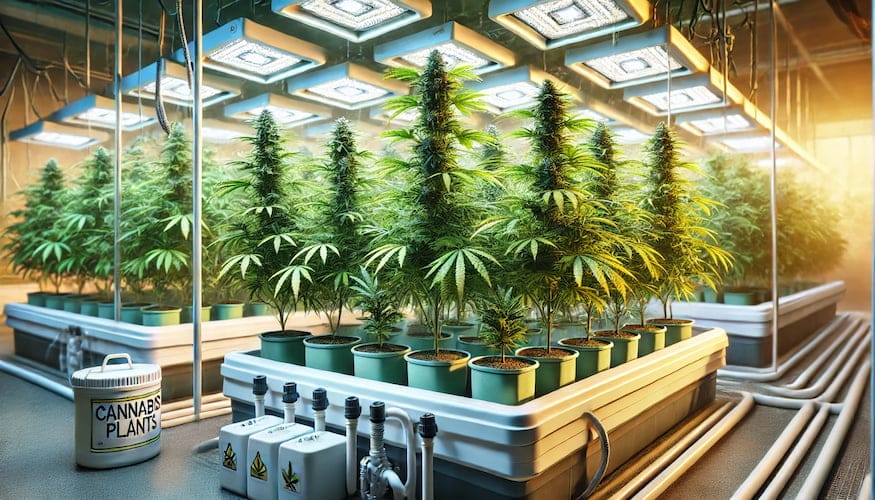
Active Hydroponic Systems for Weed
Active hydroponic systems utilize modern innovations to provide plants with water, nutrients, and oxygen. These systems offer numerous benefits and are widely used in cannabis cultivation. Let’s explore some of the most popular types of active hydroponic systems:
1. Deep Water Culture (DWC)
DWC is a popular active hydroponic system in which cannabis roots are suspended in a nutrient-rich solution. An air stone provides a constant supply of oxygen to the roots while a pump circulates the solution, ensuring adequate nutrient uptake.
2. Ebb and Flow
The ebb and flow system, also known as the flood and drain system, periodically floods the growing tray with nutrient solution and then allows it to drain. This cycle ensures that the plant roots receive oxygen as well as nutrients, promoting healthy growth.
3. Nutrient Film Technique (NFT)
In the NFT system, a thin film of nutrient solution continuously flows over the plant roots, providing a consistent supply of water and nutrients. This system is efficient and minimizes water and nutrient waste.
4. Drip System
The drip system delivers a controlled amount of nutrient solution directly to the base of each plant using an intricate network of tubing and emitters. This precise method ensures that each plant receives the necessary nutrients for optimal growth.
5. Aeroponics
In aeroponics, plant roots are suspended in the air, and a fine mist of nutrient solution is sprayed onto the roots. This system maximizes oxygen availability and nutrient absorption, resulting in fast growth and abundant yields.
Active hydroponic systems offer several benefits for growing weed:
“Active hydroponic systems provide precise control over water, nutrients, and oxygen, which leads to faster plant growth and higher yields. They are water-efficient and allow for easy automation, making them ideal for larger-scale operations.” – James Bean
To summarize, active hydroponic systems such as DWC, ebb and flow, NFT, drip systems, and aeroponics provide efficient and effective ways to cultivate cannabis. These systems offer precise control, water efficiency, increased oxygen availability, and ease of automation, allowing growers to optimize the growth and yield of their weed plants.
The Cost of Growing With Hydroponics
When considering hydroponic cultivation, one crucial aspect to keep in mind is the cost. The overall cost of growing with hydroponics can vary depending on the type of system and materials used. However, it is important to note that while the initial investment may be higher than traditional soil-based methods, the benefits and potential yields of hydroponics can outweigh the expenses in the long run.
Hydroponic Starter Kits:
For those starting out or looking for a convenient and all-inclusive solution, hydroponic starter kits are available. These kits contain the essential components needed to set up a basic hydroponic system, such as grow trays, pumps, nutrient solutions, and pH testers. While these kits can be a bit more expensive upfront, they provide a hassle-free way to get started with hydroponics.
DIY Hydroponic Systems:
On the other hand, if you prefer more flexibility and want to customize your hydroponic setup, building a DIY system is a viable option. DIY hydroponic systems allow you to choose specific equipment and materials based on your preferences and budget. This approach can be more cost-effective in the long term, as you can source components individually and potentially save money compared to purchasing a pre-designed kit.
Cost Considerations for Hydroponic Growing
When determining the cost of a hydroponic system, it is essential to consider a few key factors:
- System Size: The size of your hydroponic system will impact the overall cost. Larger systems typically require more materials and equipment, which can increase expenses. However, larger systems also have the potential to yield higher harvests.
- Equipment and Materials: The cost of equipment and materials will vary depending on their quality, brand, and specific requirements. It is important to research and compare prices to ensure you invest in reliable equipment that suits your needs.
- Lighting: Adequate lighting is crucial for successful hydroponic growth. LED grow lights are commonly used in hydroponics and can vary in cost depending on their wattage, efficiency, and features. Consider your lighting needs and budget accordingly.
- Nutrients and pH Adjusters: Hydroponic systems require nutrient solutions and pH adjusters to maintain optimal plant health. The cost of these supplies can vary depending on the brand and type of nutrients used. It is important to factor in ongoing expenses for replenishing these essential elements.
By carefully considering these factors and comparing prices, you can determine a budget that suits your needs and aspirations for hydroponic cultivation. Remember, investing in quality equipment and materials upfront can lead to more successful and efficient growing experiences in the long run.
Materials Needed for a DIY Hydroponic System
Building your own hydroponic system is an exciting project that allows you to grow plants efficiently and effectively. To get started, you will need specific materials to create a successful DIY hydroponic setup.
Hydroponic Growing Medium Options
One of the most important considerations when building a DIY hydroponic system is choosing the right growing medium. The growing medium provides support for the plants’ roots and allows them to access nutrients effectively. Here are some popular hydroponic growing medium options:
- Clay Pebbles: Clay pebbles are lightweight and porous, and they provide excellent aeration to the roots. They promote healthy root growth and offer good drainage.
- Rockwool: Rockwool is made from molten rock spun into fibers. It retains moisture well and offers good air circulation while providing support for the plants. It is commonly used for germination and propagation.
- Perlite: Perlite is a volcanic glass that is expanded by heating. It is lightweight, provides good aeration, and helps with water retention. Perlite is commonly used as a growing medium in hydroponic systems.
- Coco Coir: Coco coir is derived from coconut husks and is an organic and sustainable option. It retains water well, provides good aeration, and promotes healthy root development.
Each growing medium has its own advantages, so consider the specific requirements of your plants and choose a medium that aligns with their needs.
Other Materials Needed
In addition to the growing medium, here are some other essential materials you will need for your DIY hydroponic system:
- Buckets or Carts: These will be used to hold the nutrient solution and support the plants.
- Pumps: Electric pumps are necessary for active hydroponic systems to circulate the nutrient solution.
- Air Stones: Air stones provide oxygen to the roots in active hydroponic systems.
- Lighting Equipment: Depending on your setup and the lighting requirements of your plants, you may need grow lights to provide the necessary light spectrum.
With these materials in hand, you are ready to embark on your DIY hydroponic system journey!
Choose a Growing Medium To Get Started
Selecting the right growing medium is essential for successful hydroponic cultivation. The growing medium serves as a support system for the roots and plays a crucial role in providing nutrients and oxygen to the plants. Several options are available, each with its own unique benefits and characteristics.
Clay Pebbles
Clay pebbles, also known as hydroton or expanded clay pellets, are a popular choice among hydroponic growers. These lightweight, clay-based balls are porous and provide excellent aeration for the roots. They help maintain a well-drained environment, preventing waterlogged conditions that could lead to root rot. Additionally, clay pebbles are reusable and can be sterilized between crops, making them a cost-effective option in the long run.
Rockwool
Rockwool, made from molten rock spun into fibers, is another commonly used hydroponic growing medium. It has excellent water retention capabilities while still providing sufficient aeration to the roots. Rockwool is available in various forms, including cubes, slabs, and loose fibers, allowing for flexibility in different hydroponic setups. Its pH-neutral nature makes it suitable for a wide range of plants.
Perlite
Perlite is a lightweight volcanic glass that has been heated and expanded. It offers excellent aeration properties, promoting healthy root growth and preventing soil compaction. Perlite also has good water-draining capabilities, ensuring that the roots receive the right amount of moisture. It is commonly used as a soil amendment in traditional gardening but is also suitable for hydroponic systems.
Coco Coir
Coco coir, derived from coconut husks, is a sustainable and environmentally friendly growing medium. It retains moisture well and also provides good aeration to the roots. Coco coir is available in different forms, such as fibers, chips, or blocks, making it adaptable to various hydroponic setups. It is rich in nutrients, but it is important to rinse it thoroughly before use to remove any excess salts.
When choosing a growing medium, consider factors such as your plants’ specific needs, the desired level of moisture retention, and the ease of use and availability of the medium. Experimenting with different growing media can help you find the best option for your hydroponic garden. Ultimately, the right growing medium will provide the ideal environment for your plants’ roots to thrive and flourish.
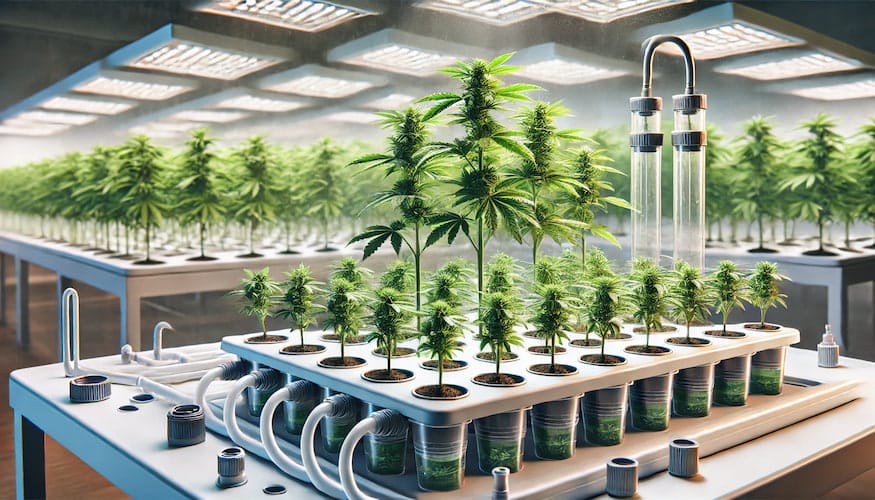
Choose a Hydroponic Growing Setup for Your Plants
When it comes to hydroponic cultivation, choosing the right setup is essential for the success of your plants. With various options available, you can select a hydroponic system that best suits your preferences and the available space. Each setup has its own unique advantages, providing different benefits for your plants. Let’s explore some popular hydroponic setups:
- Kratky Method: The Kratky method is a simple and affordable way to start your hydroponic journey. It requires no electricity or pumps, making it suitable for beginners. In this setup, plants are placed in containers with a water and nutrient solution, and the roots grow in the stagnant water. The plants gradually consume the solution, and no additional water or nutrients need to be provided until the solution is depleted.
- Deep Water Culture: Deep water culture (DWC) is another popular hydroponic setup. In this system, plants are suspended in a nutrient-rich solution with their roots submerged in the water. Aeration is provided to the roots through air stones or diffusers to ensure proper oxygen supply. DWC is known for its simplicity and is especially effective for fast-growing plants.
- Ebb and Flow: The ebb and flow, or flood and drain system, periodically floods the plant roots with a nutrient solution and then allows the excess solution to drain away. This setup requires a timer and a reservoir to automate the flooding and draining process. Ebb and flow systems provide good aeration to the roots and can be used for a wide range of plant sizes.
- Nutrient Film Technique (NFT): This technique is a hydroponic setup in which a thin film of nutrient solution flows continuously through sloped channels. The roots receive a constant supply of nutrients and air as they are exposed to the solution film. NFT systems are water-efficient and suitable for growing smaller plants with shallow root systems.
- Drip System: Drip systems are commonly used in hydroponics and provide a controlled supply of water and nutrients to the plants. A pump delivers the solution to the top of the plants, and it drips down onto the growing medium or the roots. Excess solution is collected and recirculated, making drip systems highly efficient.
- Aeroponics: Aeroponics is an advanced hydroponic setup where plant roots are suspended in the air and continuously misted with a nutrient solution. This system provides excellent oxygenation to the roots, promoting rapid growth and increased yields. Aeroponics requires precise control of the nutrient solution and misting intervals.
Each hydroponic setup has its own advantages and considerations, including plant size, water efficiency, and automation capabilities. When choosing a hydroponic setup, consider your specific needs and preferences, as well as the requirements of your plants.
Comparison of Different Hydroponic Setups
| Hydroponic Setup | Advantages |
|---|---|
| Kratky Method | Simplicity, affordability, no need for electricity or pumps |
| Deep Water Culture (DWC) | Easy to set up, suitable for fast-growing plants, good oxygen supply to roots |
| Ebb and Flow | Automation capabilities, good aeration, suitable for a wide range of plant sizes |
| Nutrient Film Technique (NFT) | Water-efficient, suitable for smaller plants, continuous nutrient supply |
| Drip System | Controlled supply of nutrients, high efficiency |
| Aeroponics | Rapid growth, increased yields, excellent root oxygenation |
Conclusion
Hydroponic cannabis cultivation offers a precise and efficient way to grow feminized seeds. By paying attention to important factors such as nutrient balance, pH levels, and lighting, growers can achieve optimal results. To maximize yield in hydroponic systems, it is crucial to choose the right growing medium and hydroponic setup.
When selecting a growing medium, options like clay pebbles, rockwool, perlite, and coco coir provide unique advantages and can cater to specific plant needs. Additionally, choosing the appropriate hydroponic setup, such as deep water culture, ebb and flow, or aeroponics, enables growers to optimize water efficiency and automation capabilities.
Maintaining regular maintenance and implementing proper harvesting techniques are key to maximizing yield from hydroponically grown feminized seeds. By carefully monitoring the growth progress and ensuring an optimal environment, growers can reap the rewards of their efforts. With the right knowledge and resources, hydroponic cultivation proves to be a rewarding and efficient method for growing cannabis.
FAQ
What are the advantages of growing feminized seeds in hydroponic systems?
Hydroponic growing offers advantages such as faster plant growth, larger yields, readily available nutrients, and energy preservation.
What are the differences between active and passive hydroponic systems?
Active hydroponic systems use electric pumps and air stones for nutrient circulation, while passive hydroponic systems rely on capillary action or simple methods for nutrient delivery.
What are some popular passive hydroponic systems for growing weed?
The Kratky method and wick system are popular passive hydroponic systems known for their simplicity, low cost, and ease of setup.
What are some popular active hydroponic systems for growing weed?
Popular active hydroponic systems for growing weed include deep water culture, ebb and flow, nutrient film technique, drip system, and aeroponics. These systems offer benefits such as water efficiency, increased oxygen availability, and automation capabilities.
How much does it cost to grow with hydroponics?
The cost of growing with hydroponics can vary depending on the type of system and materials used. Hydroponic starter kits and DIY systems offer different cost options to suit individual preferences and budgets.
What materials are needed for a DIY hydroponic system?
Materials needed for a DIY hydroponic system include a hydroponic growing medium (such as clay pebbles, rockwool, perlite, or coco coir), buckets or carts, pumps, air stones, and lighting equipment.
What are some options for hydroponic growing mediums?
Popular hydroponic growing mediums include clay pebbles, rockwool, perlite, and coco coir. Each medium has its own advantages, such as aeration properties, water retention, or sustainability.
What are some hydroponic setups to choose from?
Some hydroponic setups to consider are the Kratky method, deep water culture, ebb and flow, nutrient film technique, drip system, and aeroponics. The choice of setup should be based on factors like plant size, water efficiency, and automation needs.
How can I optimize the growth of feminized seeds in hydroponic systems?
To optimize the growth of feminized seeds in hydroponic systems, ensure you provide the appropriate nutrients, lighting, and pH levels. Regular monitoring and maintenance are important, as well as following proper harvesting techniques for maximizing yields.
Suggested Articles
;)
;)
;)



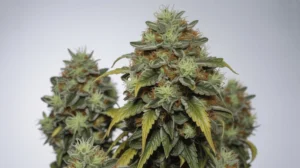
 26 Dec 2025
26 Dec 2025  8 min read
8 min read


 September 19, 2024
September 19, 2024 


RESPONSES (0)
No responses yet. Be the first to respond!